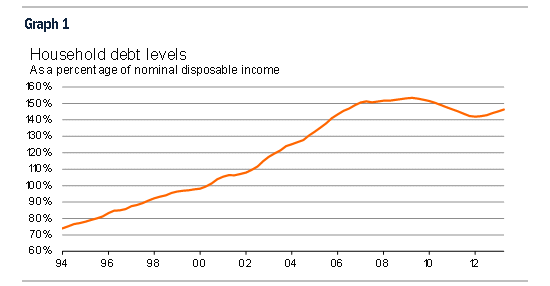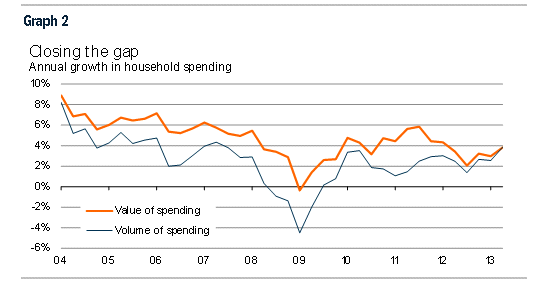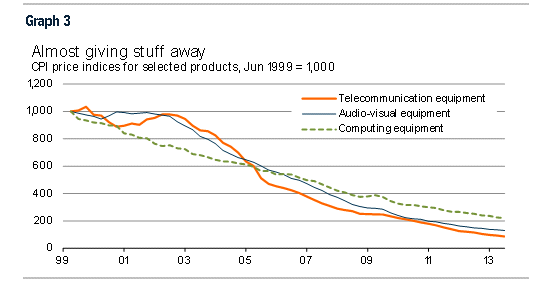
By Gareth Kiernan*

Growth in the volume of household spending reached a six-year high of 3.9%pa in the June quarter, and with some very strong quarterly increases occurring since late 2012, there are fears that that consumers are on the cusp of another spending binge like we saw at the height of last decade’s economic boom.
Although the strong demand conditions meant that trading conditions at the time felt good for businesses, a blow-out in household debt levels hinted at the unsustainability of spending growth – a fact that was ultimately exposed by the Global Financial Crisis and its aftermath.
Just 12 months ago, there were still doubts about when New Zealand’s economic recovery would genuinely get underway, along with whether there were any more major negative shocks likely to hit us from offshore.
It has to be recognised that, even now, the global economy is still relatively lacklustre, and the risk of another negative shock cannot be ruled out.
However, financial market indicators are looking more settled than 12-18 months ago and the probability of renewed upheaval seems to have diminished.
But with that background, it feels somewhat early in the economic cycle to be raising questions about the sustainability of spending growth.
The problem is that household debt is currently sitting at 146% of disposable income – down from its peak of 153% in 2009, but higher than at any time prior to 2006.
That level of debt seemingly leaves little scope for further increases in borrowing.
The latest data from the Reserve Bank shows that growth in total household debt is running at 5.6%pa – the fastest rate since late 2008.

Keeping prices down
One facet of the data that the above figures ignore is the relationship between prices and spending growth.
Some of the recent acceleration in spending growth has been driven by the fact that consumers have been able to get more bang for their buck when they’ve been buying stuff.
There’s a range of reasons why prices for consumer goods have been kept down.
- The very strong New Zealand dollar has kept down prices for tradable products.
- Prices of imported products have also been held down due to a lack of global demand and inflationary pressures.
- Spare capacity in the retail sector domestically has meant that there has been an increased prevalence of discounting and sales among shops.
- Rapid growth in online retailing, whether from local or offshore-based firms, has improved the ability of consumers to source products cheaply.
So although growth in the total value of household spending has picked up over the last year, it is not out of line with historical norms – unlike growth in the volume of spending.
In simple terms, consumers have been able to purchase more goods and services without having to stump up more cash.

Adjusting for quality
One other factor we haven’t mentioned is the quality adjustment that takes place when converting aggregate spending values to spending volumes.
Examples where these adjustments can have a significant effect on apparent volume growth include cars, electronics, phones, or computers. For example, a brand new car bought today will generally meet much higher safety standards, have better fuel efficiency, and offer a lot more additional features than a vehicle bought in 1999, but the price in dollar terms has probably not changed much during that period.
After adjusting for these quality improvements, data from Statistics NZ shows that you can get about 6% “more car” for your money now than was the case 14 years ago.
The quality adjustments for new cars pale in comparison with the adjustments made for the other products mentioned above.
CPI data shows a 78% drop in quality-adjusted prices from computing equipment since 1999, an 87% drop for audio-visual equipment, and an astounding 94% drop for telecommunication equipment.
The evolution of cell phones from simply making calls and texts to the smartphone, which is virtually a mobile version of a complete computer, mean that the price index is trying to compare apples with oranges (or perhaps apples with Apples) and is very difficult to interpret.
It’s debatable, though, whether one gets 12 times the usefulness out of a $300 phone today when compared with a $300 phone in 1999.
The same question applies to computers – does a computer with 4.5 times the processing power of a 1999 model offer 4.5 times the usefulness, or has the software simply got 4.5 times more complicated along the way as well?
We believe that recent growth in the volume of household spending has been almost “artificially” inflated by the quality adjustment going on, which has come on top of the other factors outlined above that have genuinely placed downward pressure on consumer prices.
Comparing growth in incomes with nominal spending shows that income growth has outpaced spending growth throughout most of the last four years, and there has been a massive improvement in the household savings rate since 2006.
In other words, New Zealand households currently appear to be living within their means.
We mentioned earlier that growth in household debt is picking up, but most of this lift has been due to accelerating growth in mortgage lending, in line with the accelerating housing market in Auckland, rather than any substantial lift in consumer debt.

Scope for more growth
With this background, we anticipate further strong growth in household spending is possible over the next 2-3 years without it turning into a debt-fuelled binge.
Even putting aside the effects of quality adjustments and low prices, the pick-up in household spending over the last year has come in tandem with improvements in the housing market, employment growth, and incomes.
Housing market activity typically drives up sales of durable goods such as appliances and furniture, while improved job and income security naturally leads to a greater ability and willingness to spend.
The basis for spending growth will look even more solid throughout the next year, given the $4bn+ stimulus coming into the economy from the dairy sector during 2014 and further tightening in the labour market.
And if household spending has an air of sustainability to it, then prospects are that economic growth will continue to strengthen beyond the end of next year – which is when most forecasters are currently predicting that GDP growth will peak.
----------------------------------------------------
Gareth Kiernan is the managing director at Infometrics, an economic consultancy and forecasting service, and he manages the forecasting team. You can contact him here »
5 Comments
And if household spending has an air of sustainability to it, then prospects are that economic growth will continue to strengthen beyond the end of next year – which is when most forecasters are currently predicting that GDP growth will peak.
Hmmmmm....
There's no mention of the much more magnified impact that rising interest rates will have on household expenses as opposed to ten years ago when debt levels were much lower. Add to that any tradables inflation on petrol costs etc. Any gains made on consumption capacity over the last few years will disappear fairly quickly.
Watch the reactionof consumers, households when/if interest rates are hiked next year.
Yes and Bollard later admitted publically the RBNZ's mistake. He admitted that they were too late and modest in acting in 2003/05 and let the CPI get way above their band and hit a 5%, then had to hike the OCR far more than they would have otherwise to correct their error. Wheeler in private is saying it is a lesson they fully recognise and appreciate that they're walking a fine line here in not repeating it again...
No doubt there will be pain for some when they eventually do act , but that's the intention as it slows things down...hopefully it will be a modest move, and modest pain, but itf the RBNZ gets it wrong again, it will not be that

We welcome your comments below. If you are not already registered, please register to comment
Remember we welcome robust, respectful and insightful debate. We don't welcome abusive or defamatory comments and will de-register those repeatedly making such comments. Our current comment policy is here.